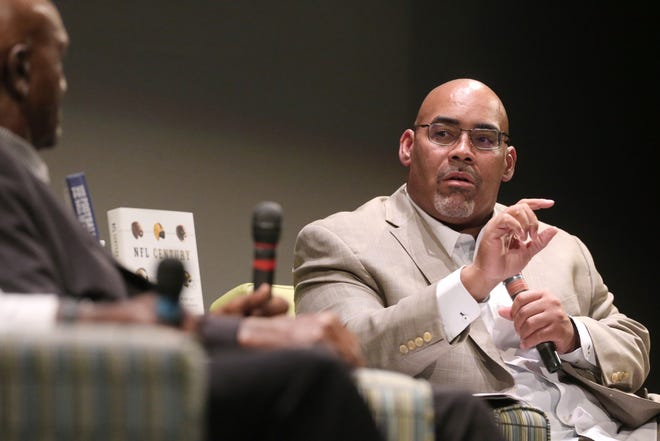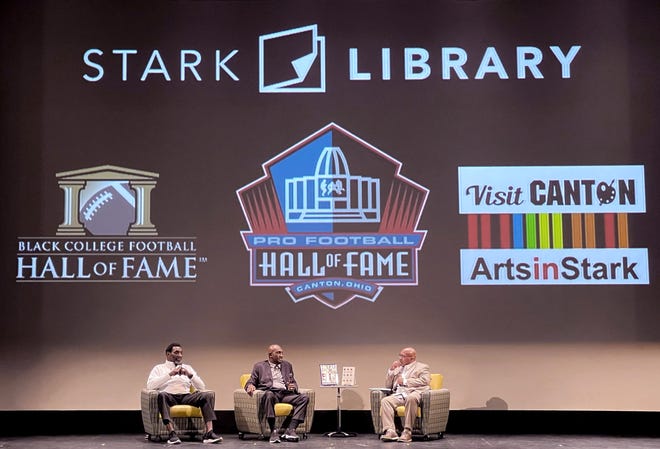
CANTON TWP. − Shortly before Anthony Munoz’s Monday speech to the Hall of Fame Luncheon Club was to start, a social media post reported Munoz would not be in the house.
This wasn’t a social media crowd. A bit after noon, when club president Jim Starrett told a full room in the Pro Football Hall of Fame that Munoz was “under the weather,” a tone of surprise arose.
It would have been a tough talk for Munoz, whose beloved Bengals had the ball late with a chance get to the Super Bowl. A stunning turnaround left Kansas City with a 23-20 win Sunday night.
Munoz, the only Bengal in the Hall of Fame, would have arrived at the head table less than 14 hours after the nightmare finish that included officiating now getting skewered on social media.
The Luncheon Club was in its own tough spot. A replacement speaker had to be found.
It wound up as two speakers, both with current roles at the Pro Football Hall of Fame.
One replacement, Adrian Allison, was supposed to introduce Munoz.

“When I got the call that he wasn’t going to be here, of course my first question was, is he really sick, or is he heartbroken?” said Allison, chief relationship officer at the Hall. The remark drew some laughter.
Munoz and Allison attended a Martin Luther King Jr. breakfast in downtown Canton on Jan. 12.
So did Joe Horrigan, the other replacement speaker on Monday. A leading football history authority, Horrigan made a career at the Hall of Fame before retiring and returning with the title “senior advisor.”

At the Jan. 12 breakfast, Horrigan moderated a discussion with Black pioneers James “Shack” Harris and Doug Williams, who were starting NFL quarterbacks in an era of predominantly white QBs.
Horrigan tapped into the Harris-Williams theme at Monday’s luncheon. He shared a personal story about Harris, who was the 192nd pick of the 1969 draft, by the Buffalo Bills, coming out of Grambling.
“He was the prototypical quarterback of the day,” Horrigan said. “He had the right size and the right arm strength. In today’s world he would have been the first overall draft pick.

“As he tells the story, ‘The Buffalo Bills thought so much of me that they drafted me in the eighth round and sent the ball boy to the airport to pick me up.'”
Horrigan knows the story because he grew up in Buffalo − he was the ball boy.
“I drove Shack to the team offices,” Horrigan said. “The first thing they started talking about was changing his position. He said, ‘That’s not happening.'”
The 1969 Bills had the No. 1 pick in the 1969 draft and spent it on USC running back O.J. Simpson.
Like Simpson, Harris played right away as a rookie.
“Coach John Rauch made a very risky decision to start Shack,” Horrigan said., “There had never been a Black quarterback start a season in the history of the NFL.
“Shack called Coach Eddie Robinson at Grambling and said, ‘What do I do? I’m a rookie. I’m nervous. I have a thumb injury.’ And Eddie Robinson says, ‘You’ve got a guy wearing No. 32 behind you.’ Hand the ball to Simpson.”

Harris lasted 11 seasons in the NFL.
Doug Williams, also from Grambling, was drafted 17th overall by Tampa Bay nine years after Harris entered the league, two years before Munoz was a No. 3 overall pick by Cincinnati. He helped get the Buccaneers to an NFC title game, but made a bigger impact with his second NFL team. On Jan. 31, 1988, Williams became the first Black quarterback to start a Super Bowl. He led Washington to a 42-10 win over the Broncos and was named MVP. Munoz and the Bengals lost to the 49ers in the following year’s Super Bowl.

“The opportunities that these two men took and made success stories that said a Black man can play quarterback,” Horrigan said. “If you look at the NFL now, I don’t even know how many Black quarterbacks there are and it doesn’t even make a difference. They’re just quarterbacks.”
Horrigan was a central figure in locating the Black College Football Hall of Fame within the walls of the Pro Football Hall of Fame. Plans call for the current temporary display to be replaced in a 3,500-square-foot area yet to be built.
Allison covered some of the men who are in both halls of fame, including Deacon Jones (South Carolina State), Jerry Rice (Mississippi Valley State) and Michael Strahan (Texas Southern).

He noted the fourth Black College Football Hall of Fame Classic, Virginia Union vs. Morehouse, will be played at Tom Benson Hall of Fame Stadium on Sept. 3. He said Virginia Union’s Jada Byers, who rushed for nearly 2,000 yards in 2022, is “one of the best running backs at any level.”
The Black College Hall of Fame is promoting the Legacy Bowl on Feb. 25, when players from Historically Black Colleges and Universities will showcase their talents for pro scouts.
Like most people in the room Monday, Allison watched the Bengals-Chiefs game and will be tuned into the Super Bowl. The quarterback battle will be Kansas City’s Patrick Mahomes vs. Philadelphia’s Jalen Hurts
“We’ve talked about Doug Williams and James ‘Shack’ Harris,” Allison said. “It is 2023, and in two weeks, for the first time in the history of the Super Bowl, there will be two Black quarterbacks (starting).
“I think we’ve come a long way.”
Reach Steve at [email protected]
On Twitter: @sdoerschukREP